S&P 500 Approaches 1999 High
By Colin Twiggs
April 28, 2007 4.00 p.m. AET (2:00 a.m. ET)
These extracts from my trading diary are for educational purposes and should not be interpreted as investment advice. Full terms and conditions can be found at Terms of Use.
USA: Dow, Nasdaq and S&P500
The Dow Jones Industrial Average is headed for a test of
the upper border of the trend channel. Reversal below the new
support level of 12800, while not expected, would signal a test
of the lower channel line. Close observation will reveal that
the channel lines are not symmetrical: I have dragged the top
channel line closer to the linear regression line because in
this case data is not evenly distributed (around the LR line).
Twiggs Money Flow (21-day) is climbing sharply, signaling
strong accumulation.
Reversal below 12000 is highly unlikely, but would warn of
another secondary correction.
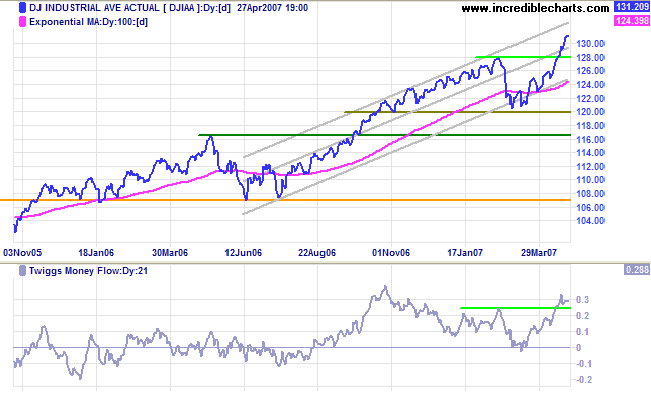
Long Term: The primary up-trend continues. The first line of support is at the May 2006 peak of 11600, with primary support at the June 2006 low of 10700. We are in phase 3 of a bull market and strong primary trend moves are expected -- just don't be blinded by the euphoria.
Short Term: The Dow shows signs of a strong up-trend, with tall blue candles followed by short consolidations.
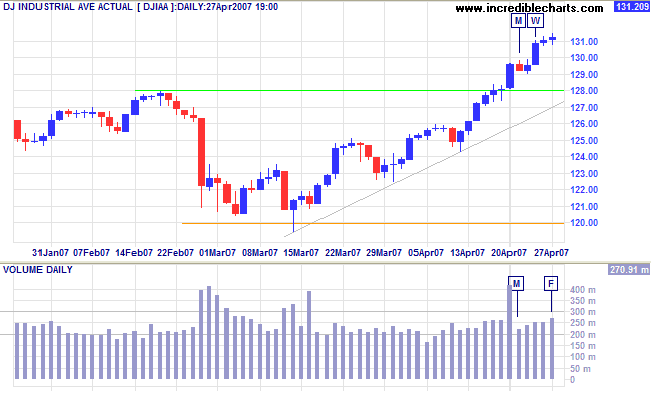
The Dow Jones Transportation Average is retracing to test the new support level at 5000. Respect of support would be a strong bull signal.
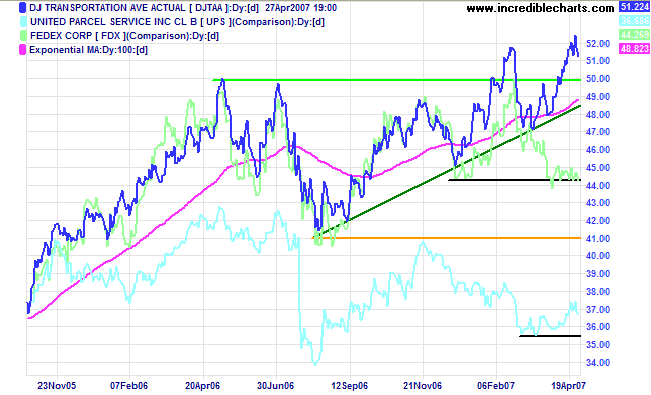
Fedex and UPS have failed to follow the index. Divergence would be a bearish sign for the economy.
The Nasdaq Composite is climbing steeply after the
breakout above 2500, but another retracement to test the new
support level remains possible.
Twiggs Money Flow (21-day) signals long-term accumulation
having respected the zero line for several months.
Long Term: The primary up-trend continues, with support
at 2350 and 2000.
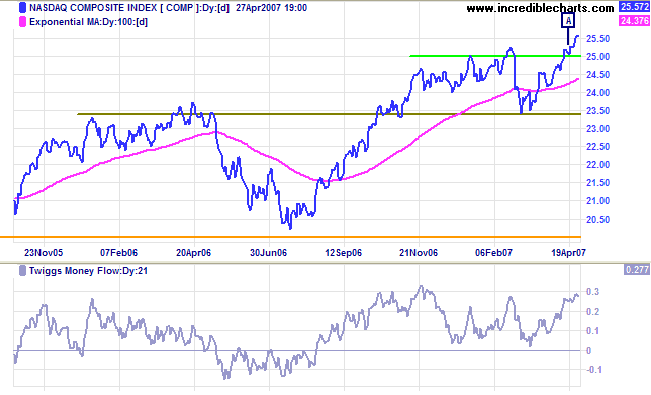
The S&P 500 is consolidating below resistance at its
all-time high of 1500. Narrow consolidation would be a strong
bull signal, while retracement below the recent low of 1375
would be bearish.
Twiggs Money Flow (21-day) signals both short- and
long-term accumulation after breaking above its previous
peak.
Long Term: The primary trend is up, with support levels
at 1325 and 1220.
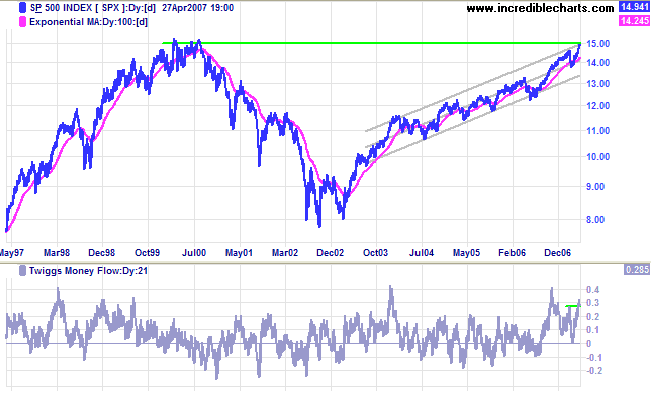
LSE: United Kingdom
The FTSE 100 formed a short-term
flag at its February high of 6450. An upward breakout is
expected to test the upper border of the trend channel (drawn
at 2 standard deviations around a linear regression line) which
also coincides with the 1999 all-time high of 6950. Downward
breakout from the flag, though less likely, would signal a test
of the lower channel border.
Long Term: The primary up-trend continues. A fall below
6000 is not expected, but would warn of a test of primary
support at 5500.
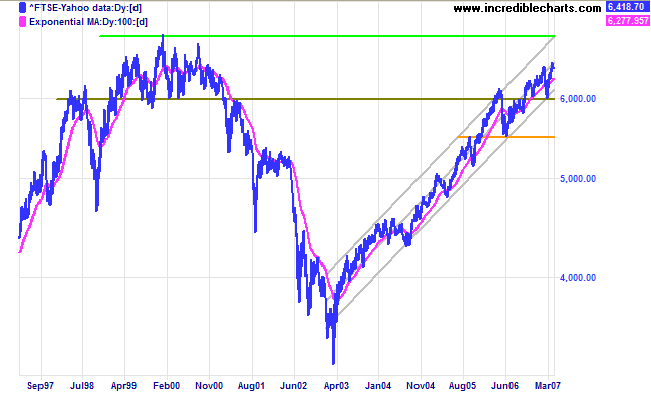
Nikkei: Japan
The Nikkei 225 is below 17500 and testing the lower
border of the trend channel. A break below the lower border
would warn of a test of support at the March low of 16600. And
a fall below 16600 would be a strong bear signal, warning of a
test of primary support at 14200. Respect of the lower channel
line, on the other hand, would signal continuation of the
up-trend. Declining
Twiggs Money Flow (21-day) warns of short-term
distribution.
Long Term: The primary trend remains up.
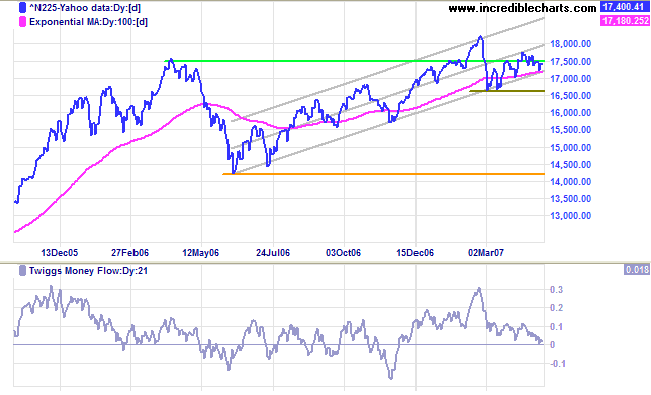
ASX: Australia
The All Ordinaries is at the upper border of the trend
channel (drawn at 2 standard deviations around a linear
regression line), and shows little inclination to follow the
direction of US markets. Bearish divergence on
Twiggs Money Flow (21-day) signals long-term distribution,
while the sharp fall during recent weeks reflects the same
pattern in the short-term. A swing to rest the lower border of
the trend channel is likely, but I remain wary of the bullish
influence of US markets.
Long Term: The primary up-trend continues, with the
first line of support at the May 2006 high of 5300 and primary
support at the June 2006 low of 4800.
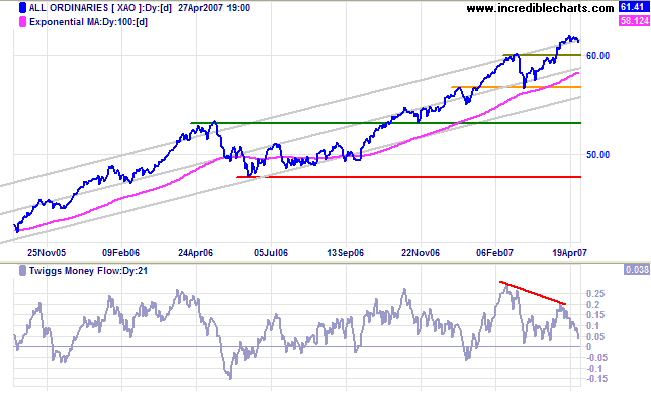
Short Term: Narrow consolidations are normally strong continuation patterns in a trend, but rising rather than falling volume warns us to exercise caution. A blue candle that closes above 6200 would signal continuation of the up-trend, while a further fall below 6150 would warn of a test of 6000.
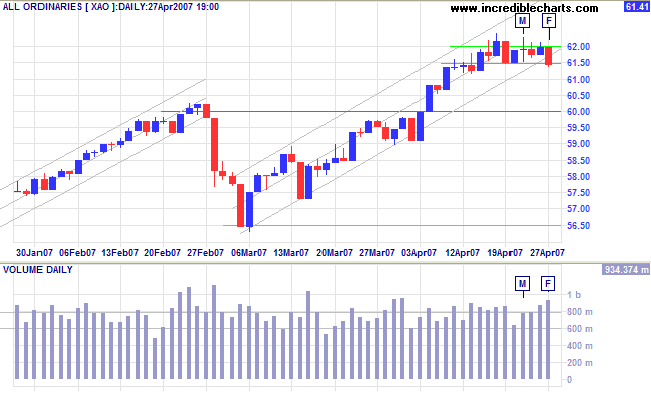
"The Australian example provides evidence that removing large
numbers of firearms from a community can be associated with a
sudden and on-going decline in mass shootings, and accelerated
declines in total firearm-related deaths, firearm homicides and
firearm suicides."
~ Report by professor Simon Chapman and associate professor
Philip Alpers from the University of Sydney's School of Public
Health on the effectiveness of Australia's restrictive gun laws
introduced after the 1996 Port Arthur massacre of 35 civilians.
To understand my approach, please read Technical Analysis & Predictions in About The Trading Diary.

Author: Colin Twiggs is a former investment banker with almost 40 years of experience in financial markets. He co-founded Incredible Charts and writes the popular Trading Diary and Patient Investor newsletters.
Using a top-down approach, Colin identifies key macro trends in the global economy before evaluating selected opportunities using a combination of fundamental and technical analysis.
Focusing on interest rates and financial market liquidity as primary drivers of the economic cycle, he warned of the 2008/2009 and 2020 bear markets well ahead of actual events.
He founded PVT Capital (AFSL No. 546090) in May 2023, which offers investment strategy and advice to wholesale clients.
